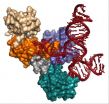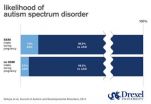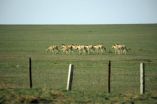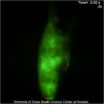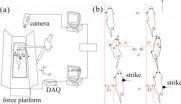(Press-News.org) MADISON, Wis. — A grandfather clock is, on its surface, a simple yet elegant machine. Tall and stately, its job is to steadily tick away the time. But a look inside reveals a much more intricate dance of parts, from precisely-fitted gears to cable-embraced pulleys and bobbing levers.
Like exploring the inner workings of a clock, a team of University of Wisconsin-Madison researchers is digging into the inner workings of the tiny cellular machines called spliceosomes, which help make all of the proteins our bodies need to function. In a recent study published in the journal Nature Structural and Molecular Biology, UW-Madison's David Brow, Samuel Butcher and colleagues have captured images of this machine, revealing details never seen before.
In their study, they reveal parts of the spliceosome — built from RNA and protein — at a greater resolution than has ever been achieved, gaining valuable insight into how the complex works and also how old its parts may be.
By better understanding the normal processes that make our cells tick, this information could some day act as a blueprint for when things go wrong. Cells are the basic units of all the tissues in our bodies, from our hearts to our brains to our skin and lungs.
It may also help other scientists studying similar cellular machinery and, moreover, it provides a glimpse back in evolutionary time, showing a closer link between proteins and RNA, DNA's older cousin, than was once believed.
"It gives us a much better idea of how RNA and proteins interact than ever before," says Brow, a UW-Madison professor of biomolecular chemistry.
The spliceosome is composed of six complexes that work together to edit the raw messages that come from genes, cutting out (hence, splicing) unneeded parts of the message. Ultimately, these messages are translated into proteins, which do the work of cells. The team created crystals of a part of the spliceosome called U6, made of RNA and two proteins, including one called Prp24.
Crystals are packed forms of a structure that allow scientists to capture three-dimensional images of the atoms and molecules within it. The crystals were so complete, and the resolution of the images so high, the scientists were able to see crucial details that otherwise would have been missed.
The team found that in U6, the Prp24 protein and RNA — like two partners holding hands — are intimately linked together in a type of molecular symbiosis. The structure yields clues about the relationship and the relative ages of RNA and proteins, once thought to be much wider apart on an evolutionary time scale.
"What's so cool is the degree of co-evolution of RNA and protein," Brow says. "It's obvious RNA and protein had to be pretty close friends already to evolve like this."
The images revealed that a part of Prp24 dives through a small loop in the U6 RNA, a finding that represents a major milestone on Brow and Butcher's quest to determine how U6's protein and RNA work together. It also confirms other findings Brow has made over the last two decades.
"No one has ever seen that before and the only way it can happen is for the RNA to open up, allow the protein to pass through, and then close again," says Butcher, a UW-Madison professor of biochemistry.
Ultimately, Butcher says they want to understand what the entire spliceosome looks like, how the machines get built in cells and how they work.
While this is the first protein-RNA link like this seen, Brow doesn't believe it is unique. Once more complete, high-resolution images are captured of other RNA-protein machines and their components, he thinks these connections will appear more commonly.
He hopes the findings mark a transition in the journey to understand these cellular workhorses.
"It's exciting studying these machines," he says. "There are only three big RNA machines. Ours evolved 2 billion years ago. But once it's figured out, it's done."
The U6 crystal structure was imaged using the U.S. Department of Energy Office of Science's Advanced Photon Source at Argonne National Laboratory. The work was funded by a joint grant from the National Institutes of Health shared by Brow and Butcher.
INFORMATION:
-- Kelly April Tyrrell, 608-262-9772 or ktyrrell2@wisc.edu
NOTE: An animation to accompany this release can be downloaded at http://bit.ly/SodaqN
Scientists capture most detailed images yet of tiny cellular machines
2014-06-03
ELSE PRESS RELEASES FROM THIS DATE:
Preventive services by medical and dental providers and treatment outcomes
2014-06-03
Alexandria, Va., USA – The International and American Associations for Dental Research (IADR/AADR) have published a paper titled "Preventive Services by Medical and Dental Providers and Treatment Outcomes." Nearly all state Medicaid programs reimburse non-dental primary care providers (nDPCPs) for providing preventive oral health services to young children; yet, little is known about how treatment outcomes compare to children visiting dentists. This study compared the association between the provider of preventive services (nDPCP, dentist or both) to Medicaid-enrolled children ...
New Ichthyosaur graveyard found
2014-06-03
Boulder, Colo., USA – In a new study published in the Geological Society of America Bulletin, geoscientists Wolfgang Stinnesbeck of the University of Heidelberg and colleagues document the discovery of forty-six ophthalmosaurid ichthyosaurs (marine reptiles). These specimens were discovered in the vicinity of the Tyndall Glacier in the Torres del Paine National Park of southern Chile. Among them are numerous articulated and virtually complete skeletons of adults, pregnant females, and juveniles.
Preservation is excellent and occasionally includes soft tissue and embryos. ...
Miniature digital zenith telescope for astronomy and geoscience
2014-06-03
As a kind of ground-based optical astrometric instrument, zenith telescope observes stars near zenith, which substantially reduces the influence of normal atmospheric refraction. Its high-precision observations can be used to calculate astronomical latitude and longitude, which are mainly applied in mobile measurement for deflection of the vertical, long-term measurement for the variations of the vertical, and related researches of astronomical seismology. Utilizing CCD camera, high-precision tiltmeter and other new technologies and devices, Chinese researchers have successfully ...
Image release: A violent, complex scene of colliding galaxy clusters
2014-06-03
Astronomers using the Karl G. Jansky Very Large Array (VLA) and the Chandra X-Ray Observatory have produced a spectacular image revealing new details of violent collisions involving at least four clusters of galaxies. Combined with an earlier image from NASA's Hubble Space Telescope (HST), the new observations show a complex region more than 5 billion light-years from Earth where the collisions are triggering a host of phenomena that scientists still are working to understand.
The HST image forms the background of this composite, with the X-ray emission detected by Chandra ...
In utero exposure to antidepressants may influence autism risk
2014-06-03
PHILADELPHIA (June 2, 2014) – A new study from researchers at Drexel University adds evidence that using common antidepressant medications during pregnancy may contribute to a higher risk of autism spectrum disorders (ASD) in children, although this risk is still very small.
Results from past studies of prenatal use of selective serotonin reuptake inhibitors (SSRIs) and ASD risk have not been consistent. An ongoing challenge in this line of research is trying to tease apart potential effects of the medication on risk from the effects associated with the condition for ...
Breaking down barriers
2014-06-03
The Gobi-Steppe Ecosystem is world renowned for its populations of migratory ungulates, which cover great distances in search of forage. Researchers at the Research Institute of Wildlife Ecology at Vetmeduni Vienna have documented, that in just one year an individual wild ass can range over an area of 70,000 km2. "Wild asses and gazelles have to be permanently on the move and travel very long distances to find enough food. Rainfall is highly variable in this region. As a consequence pastures are patchy and unpredictable in space and time," explains Petra Kaczensky, one ...
Lasers and night-vision technology help improve imaging of hidden lymphatic system
2014-06-03
VIDEO:
This is a movie illustrating the lack of lymphatic flow in the lower leg of a subject with lymphedema.
Click here for more information.
WASHINGTON, June 3, 2014—The human lymphatic system is an important but poorly understood circulatory system consisting of tiny vessels spread throughout the body. This "drainage" network helps guard against infections and prevents swelling, which occasionally happens when disease or trauma interrupts normal lymphatic function. Chronic ...
Security guard industry lacks standards, training
2014-06-03
EAST LANSING, Mich. --- Despite playing a more important role in the wake of 9/11, the security guard industry remains plagued by inadequate training and standards in many states, indicates new research by Michigan State University criminologists.
Formal training of the nation's 1 million-plus private security officers is widely neglected, a surprising finding when contrasted with other private occupations such as paramedics, childcare workers and even cosmetologists, said Mahesh Nalla, lead investigator and MSU professor of criminal justice.
By and large, security ...
Balancing strategy to lateral impact in a rat Rattus norregicus
2014-06-03
The balancing strategy to lateral impact in a rat is closely related to the striked position of the body. The research result can be inspired to improve the robustness of bionic robot. This was found by Dr. JI Aihong and his group from Institute of Bio-inspired Structure and Surface Engineering, Nanjing University of Aeronautics and Astronautics. This work, entitled "Balancing strategy to lateral impact in a rat Rattus norregicus", was published in Chinese Science Bulletin (In Chinese),2014, Vol 59(13) issue.
The center of mass(COM) of animal's body always falls ...
Modeling and simulation in the big data era
2014-06-03
The big data era bring the confusions, challenges and opportunities to the modeling and simulation field tightly associated with big data. The Chinese Association for System Simulation undertook the 81st new ideas and new theories academic salon of China Association for Science and Technology. This salon, directed by Li Bohu (academician of Chinese Academy of Science) and Hu Xiaofeng (professor of National Defense University, PLA) as the leading scientists, called about 20 specialists and scholars from all the country together. They deeply investigated big data from different ...
